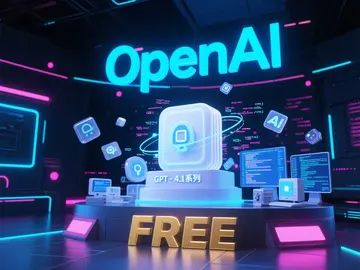The Dawn of Smarter AI: What Makes GPT-4.1 the BEST Programming Companion?
OpenAI has once again redefined the boundaries of artificial intelligence with the release of the GPT-4.1 series, a trio of models that promise unprecedented programming prowess, cost efficiency, and contextual awareness. Designed to outperform its predecessors like GPT-4o and GPT-4.5, this launch introduces three specialized variants—GPT-4.1, GPT-4.1 mini, and GPT-4.1 nano—each tailored for distinct use cases. With a staggering 1-million-token context window and 40% faster code generation, these models are poised to transform industries from software development to legal analytics. But how do they stack up against existing tools, and what makes them a game-changer for developers?

Why Are Developers Calling GPT-4.1 the "AI Pair Programmer of the Future"?
Benchmark-Breaking Programming Prowess
The GPT-4.1 flagship model achieves a 54.6% accuracy on the SWE-bench Verified test—a 21.4% leap over GPT-4o. This benchmark evaluates real-world software engineering skills, requiring models to navigate codebases, write functional patches, and pass unit tests. For context, solving just 30% of SWE-bench tasks was considered groundbreaking in 2024. The model’s enhanced diff format adherence (a method to output only modified code lines) reduces redundant file rewrites by 50%, while its 32,768-token output limit enables editing of large code files in a single API call.
Frontend Development Breakthroughs
In blind tests, 80% of human evaluators preferred websites built by GPT-41 over GPT-4o. The model demonstrates improved consistency in tool usage and reduced "hallucinations" when generating UI components. Companies like Windsurf report a 30% efficiency boost in frontend workflows, with GPT-4.1 automatically fixing dependency conflicts and optimizing React code structure.
Can a 1-Million-Token Context Window Truly Handle Complex Tasks?
The series’ 1-million-token capacity—equivalent to 700,000 words or eight full React codebases—enables groundbreaking applications:
Legal Document Analysis: Thomson Reuters saw a 17% accuracy improvement in multi-document review tasks.
Codebase Refactoring: Developers can now submit entire repositories for architecture optimization suggestions.
Video Understanding: Achieves 72% accuracy on the Video-MME benchmark for unsubtitled long-form content analysis.
Is GPT-4.1 Mini the BEST Cost-Performance Tradeoff for Startups?
Priced at 83% lower cost than GPT-4o with half the latency, GPT-4.1 mini delivers comparable intelligence for:
Real-time chatbots requiring sub-second responses
Batch processing of API requests at scale
Educational platforms needing affordable AI tutors
Early adopters like Qodo report 55% preference for GPT-4.1 mini in code review tasks, praising its ability to maintain context across pull requests while keeping costs under $0.42 per million tokens.
How Does GPT-4.1 Nano Democratize FREE AI Experimentation?
The nano variant, priced at $0.12 per million tokens, brings enterprise-grade AI to:
Mobile apps requiring low-latency autocomplete
IoT devices with limited compute resources
Open-source projects needing FREE tier integrations
Despite its compact size, it scores 80.1% on MMLU (Massive Multitask Language Understanding), outperforming GPT-4o mini in classification tasks. Developers can now prototype AI features without budget constraints—a stark contrast to the $20/million-token pricing of 2023 models.
The Elephant in the Room: Why Did OpenAI Skip to Version 4.1?
The versioning confusion (from GPT-4.5 to 4.1) sparked memes across developer forums. OpenAI’s CTO admitted the numbering reflects targeted optimizations rather than generational leaps. As one Reddit user joked: "It’s like iPhone skipping from 14 to 16—but if 16 actually works better!" This pragmatic approach prioritizes real-world utility over marketing hype, focusing on measurable improvements in coding and instruction adherence.
Conclusion: A New Era for AI Tools
The GPT-4.1 series marks a paradigm shift from "bigger models" to "smarter specialization." By offering tailored solutions across cost and performance spectrums, OpenAI empowers developers to choose the RIGHT tool—not just the most powerful one. With FREE trials available through partners like Windsurf and Cursor, even indie developers can now harness AI that rivals human engineers in specific domains. As the line between developer and AI blurs, one question remains: How will YOU leverage these tools to redefine what’s possible?
See More Content about AI NEWS
